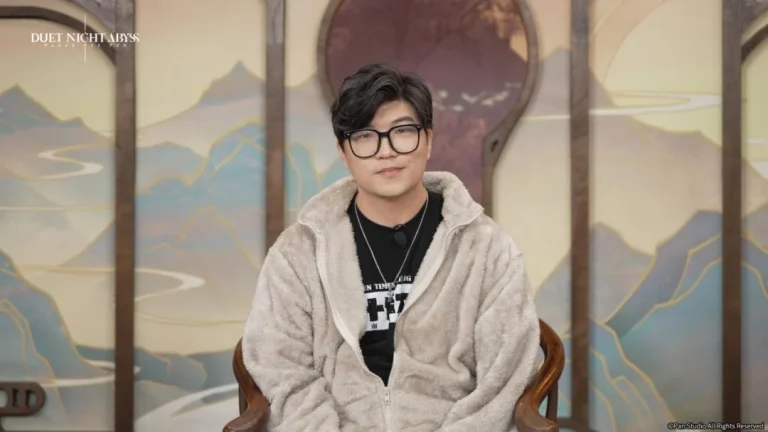Like a Dragon: Infinite Wealth, the latest entry to Sega’s Like a Dragon series, sold over one million units worldwide within a week of its release, breaking the franchise’s past records. But the grander the scale of a title, the easier it is for the individual efforts behind it to go unnoticed. That’s why we collaborated with SEGA to interview members of each section of RGG Studio and find out all there is to know about their meticulous work on the Like a Dragon franchise.
In this edition, we speak to lead designer Michihiko Hatoyama and art director Nobuaki Mitake about the Like a Dragon series’ background design. This interview focuses on how the team conducted location scouting in Hawaii, the series’ first overseas setting, as well as the particulars of environment creation. Read Part One of this interview here.
Having our games compared with reality doesn’t scare us – it makes us feel validated
――I would like to ask you about Hawaii, the main stage of Like a Dragon: Infinite Wealth. Did you do any location scouting in Hawaii? If so, for how long and with how many staff members?
Michihiko Hatoyama(Hatoyama hereafter):
A total of seven members from the planning and background team went to Hawaii and spent about a week location scouting.
――A week? What did the background team cover?
Hatoyama:
Apart from photography and light measurements of various locations, which we always perform, we took the time to conduct fixed-point observations of how people in Hawaii move and work. We also looked at what kind of cars are being driven around Hawaii, and worked out how often certain models and colors appeared in order to make the game look more lifelike.
We also visited stores that Infinite Wealth is collaborating with. We not only took pictures of the interiors, but also asked the local staff to pose in various uniforms and shared the images with the character designers. There was just so much work to be done! Hawaii isn’t a location like Kabukicho, where we can go as often as we want, so we were constantly running the 360-degree camera to make sure we didn’t miss any shots.
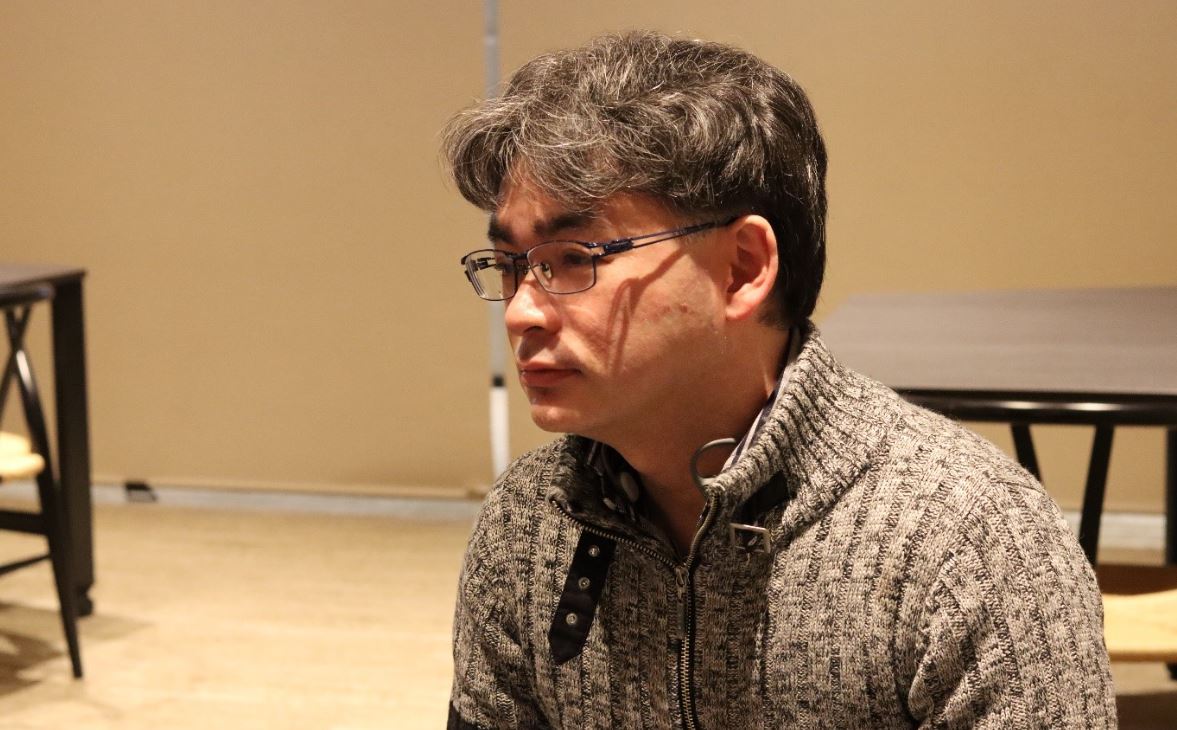
――I see, you were there on behalf of the art team, after all. Did you have any time left to enjoy Hawaii?
Hatoyama:
I was busy, but I knew that in order to portray the setting in an attractive way, I had to enjoy the place myself, so I took the time to go swimming in the sea and did other fun things alongside proper location scouting (laughs).

――Was there anything you forgot to film or photograph and only remembered once you were back in Japan?
Hatoyama:
We shot so many places in Hawaii that I can confidently say there was nothing we left out. When photographing stores, we even asked shopkeepers to show us their backyards. I have experience recreating towns all over Japan in-game, so I have a good idea of what kind of areas often get overlooked during location scouting.
――Yeah, I guess it’s a problem if you forget to record something even in Japan. During location scouting, what kind of data did you particularly focus on obtaining?
Hatoyama:
To begin with, backgrounds cannot be created without a sense of scale, so we used laser measures to determine the height of the palm trees and the width of the roads. However, we did not have time to measure everything, so we took pictures of our staff against various backgrounds and used their heights to determine the scale of things.


――Some people in Hawaii have said that Like a Dragon: Infinite Wealth and the real Hawaii are quite similar. I’ve also seen influencers compare the two side-by-side.
Hatoyama:
I think I’ve seen those videos! It’s nice to hear people say they look the same. I also love videos that compare real-life locations with Like a Dragon, they make me happy as a creator. Sometimes while watching, I think, “Please, compare this too, and that as well! It took a lot of effort to make!” (laughs)
――But when compared to the real thing, the differences in the game can potentially stand out more…Isn’t it scary to be compared so much? (laughs)
Nobuaki Mitake (Mitake hereafter):
It’s not! (laughs) The more our game environments get compared to reality, the more it shows that players found it realistic, so it makes me happy rather than scared to know that we did a good job of depicting the location.

――Various areas of Hawaii are depicted in Like a Dragon: Infinite Wealth, even the so-called dangerous districts. Did you visit and research such places in person?
Hatoyama:
We had heard that Chinatown at night is particularly dangerous, but we did our location scouting anyway. The market was open in the morning and there were many people around, so we took advantage of that time to shoot things swiftly, but at night, we stuck to only scouting the area by car.

――I see! Does the in-game Chinatown’s higher percentage of enemies reflect the real-life area’s lack of safety?
Hatoyama:
Yes, it does. But even outside of Chinatown, there are always car alarms going off at night in Hawaii, and I realized that even though it is considered a tourist hub, there is a dangerous side to it. It is a nice place, but we had to be careful depending on the area and time of day.

――By the way, were there any areas of Hawaii that were particularly difficult to recreate?
Hatoyama:
Basically, any real place is difficult to recreate. Although not a recreation, a particularly difficult area to make was the Little Japan area (the Japanese Town), which does not exist in the real Hawaii. We had a lot of trouble, but I think we were successful in depicting it as a kind of “make-believe Japan,” using Japanese motifs such as shrines and Shinobi Sushi. Like with Yakuza 0, the entire background team had a blast while creating it precisely because it doesn’t exist.

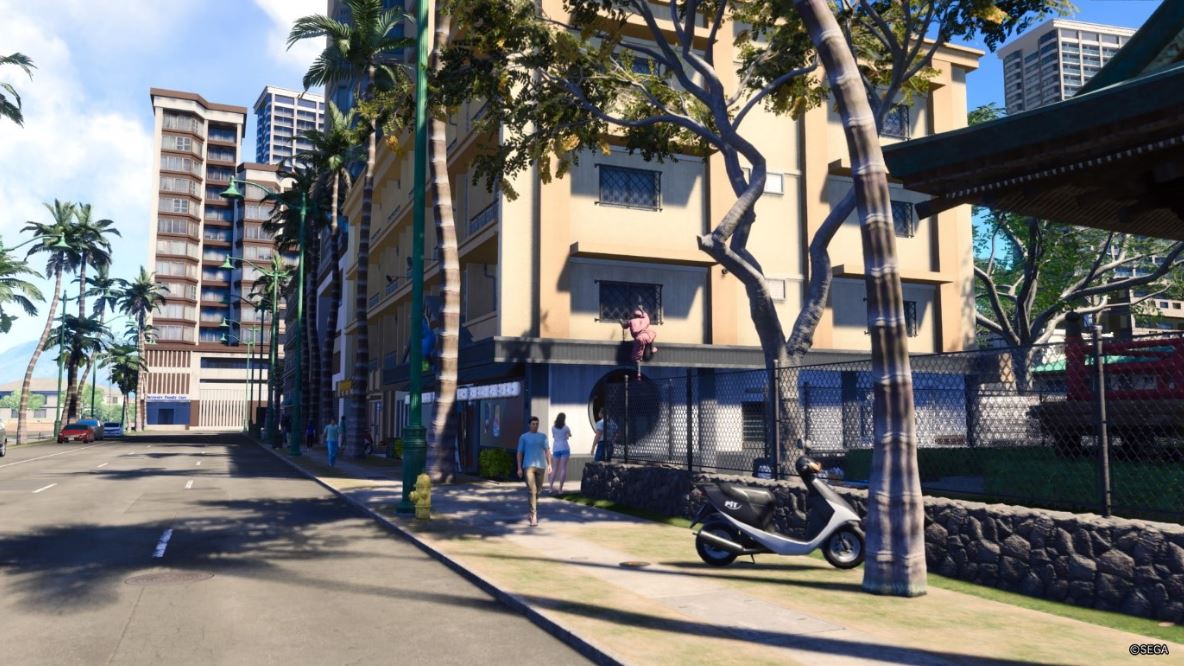
Mitake:
In fact, we purposely didn’t reproduce the layout of real-life areas as-is in the game, but rather we structured the streets in such a way that it would be more entertaining and in line with the game’s progression. In the early stages of development, we discussed level design specifications with the planners, such as what areas should include strong enemies and how the player should reach them.
――Did anything memorable happen during location scouting?
Hatoyama:
When you film for long periods of time, people find you suspicious (laughs). It’s a common occurrence during location scouting. At one point, a group of 5 or 6 of our staff members were filming in a shopping center and got approached about it.
――(Laughs) The Anaconda Shopping Center, which surely benefited from on-site research, is one of the areas in Like a Dragon: Infinite Wealth that feels particularly dense and detailed. How many people were on the background team for the Hawaii map?
Hatoyama:
There were times when we had to work on different projects at the same time, so it was a fluid system, but I would say that around a dozen people worked on the Hawaii map.
Mitake:
Yeah, that’s about right. The background team was about 20 people in total, since the battle stages, such as dungeons, were handled by different staff. I don’t know if that’s considered too few or too many (laughs).
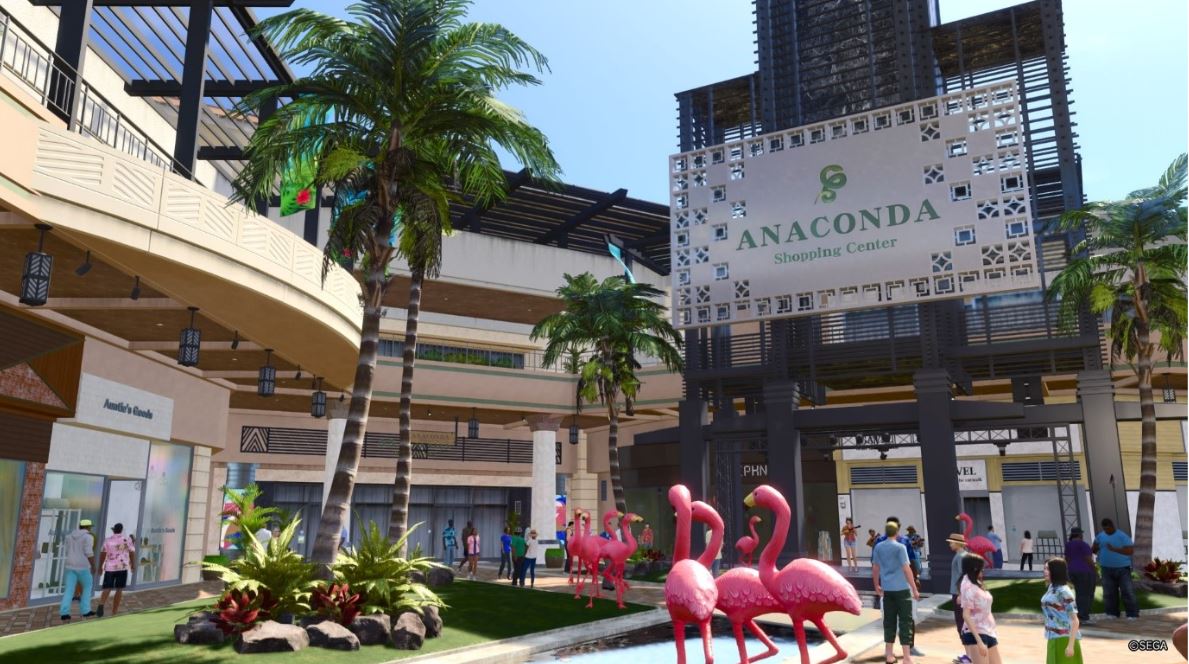
Hawaii was created without using “legacy” assets in order to clearly distinguish it from Japan
――What were some of the challenges in actually creating the graphic assets for Hawaii?
Hatoyama:
Hawaii is about three times the size of Isezaki Ijincho in Yokohama, the setting of Yakuza: Like a Dragon (Yakuza 7), so the sheer volume of assets was a challenge. As for the background composition, it was not difficult to fill the map itself because the buildings are on a larger scale than in Japan. However, we had a hard time creating a sense of density on the screen because of that, so we used silhouettes of plants, as well as the skyline to add depth.
――Indeed, Hawaii seemed to be the most spacious of the series’ settings. Its sheer size must have made things difficult.
Hatoyama:
The other difficulty was it being overseas. Until now, the setting was always in Japan, even though the locations changed. However, even the texture of the ground in Hawaii and Japan is completely different, so unlike the first half of the game, we could not use any past materials and had to create all assets from scratch.
――You didn’t use any past assets?!
Hatoyama:
Yes, we wanted to emphasize the gap between Japan and Hawaii. We also tried to create the feeling of being in a foreign country right from the first event, when you’re looking for a cab upon arriving in Hawaii. We went through trial and error for things like showing how cars are parked. In Japan, cars are usually parked facing backward, but in Hawaii, cars are parked facing forward for security reasons, so we checked with the local coordinators to learn more about such aspects of Hawaiian culture.

Mitake:
Even the way the sun shines in Hawaii is different from how it shines in Japan, so Hatoyama and the rest of the background team were very particular about this. We used our experience from location scouting as a basis, but also made exaggerations in order to recreate the atmosphere of Hawaii that everyone imagines. We wanted to make players really feel as if they had just “arrived in Hawaii.”
――Is there anything you would like players to take note of when it comes to Hawaii’s assets? It must have been difficult to design the signs and billboards, which I know you’re particular about.
Mitake:
For the signs, I tried to convey everything I noticed as I walked around Hawaii on my own. Also, the shop names were created in cooperation with Sega of America. We asked them for tips on appropriate names that would convey the atmosphere of the shops we wanted to make.
――So, the “sign police” were active in Hawaii as well (laughs). Were there Diamond Vision displays in Hawaii too?
Mitake:
Unfortunately, Hawaii didn’t have Diamond Vision displays, so I didn’t get my chance… It’s a shame (laughs). On the other hand, we held an art contest in the studio to choose the murals in the Cultural District area.
――So you went, “who wants to draw murals?” and people volunteered? That’s interesting (laughs).
Mitake:
Yes, but I left it to Hatoyama, the background leader, to decide which entries to include in the game. Since I also participated in the contest, our positions as boss and subordinate got reversed in that part of the process (laughs).
Hatoyama:
(Laughs) Not only designers, but also some members of the planning team sent in entries. It wasn’t a matter of who was more skilled, but of assembling murals of various styles.


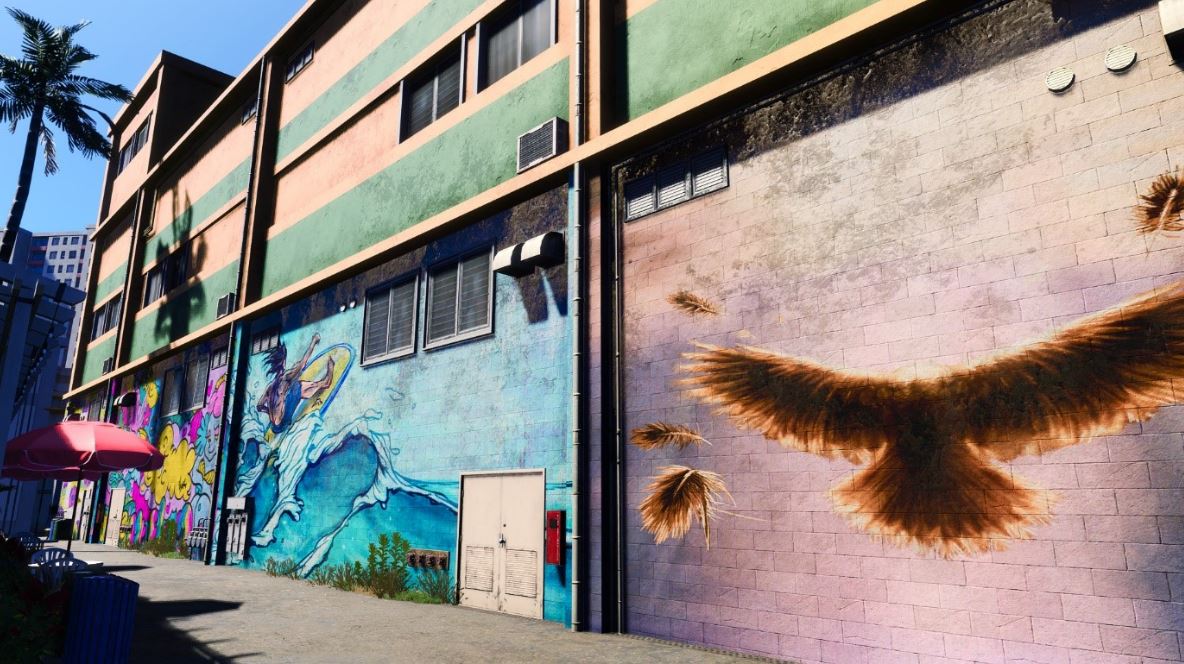
――Yeah, I guess, as you mentioned about signs earlier, it would be weird if the murals were all in the same style.
Mitake:
On a different note, when creating Hawaiian food, we didn’t use the photographs we took on-site. After all, we couldn’t make the food look exactly the same as the products from a business that we didn’t have a partnership with. That’s why we had the staff cook the dishes and take photos of them, and made it into an open contest, like for the murals (laughs).
We want players to interact with the quirks and details hidden in the game
――Thank you very much. Last but not least, is there anything you would you like to say to our readers?
Hatoyama:
Like a Dragon: Infinite Wealth is packed with stuff that the team put a lot of effort into, so we would be very happy if you could explore the game thoroughly and share your impressions with us on social media. This is what energizes the development team, and we would like to continue to create games that meet everyone’s expectations.
Mitake:
Even if you’ve already cleared the game, you may have missed many details in the background, so I would be elated if players took a closer look post-game. There are also some easter eggs hidden by the designers throughout the game, so I hope you will discover and enjoy them. As an example, although it doesn’t relate to backgrounds, there is an image of Kiryu and Ichiban standing in the start menu of Like a Dragon: Infinite Wealth, but on rare occasions, it switches to Adachi and Namba.

――What? Really?!
Mitake:
It’s probability-based, so there’s no surefire way to see it, but give it a try a few times. I was happy to hear from some people on social media that they found it. Inevitably, people started wondering if there were other character combinations too, but I’m sorry, there’s only Adachi and Namba…
――I love to see designers taking the initiative to add such quirks.
Mitake:
The schedule is tight, and it is hard work, but each member of the team is constantly thinking of how to make the game more entertaining while juggling their own workload. On a personal note, I found coming up with the key visual for Like a Dragon: Infinity Wealth very difficult (laughs).
――So it was you who came up with the key visual for this entry?
Mitake:
Yeah, I agonized over it quite a bit. We always have actors appear as one of the main features of the series, and normally the goal is to make them stand out, but for this title, I kept the design a little low-key and focused on the number “8.” The “8” design consists of two circles, one for Ichiban’s party and the other for Kiryu’s party.

――I knew it! After playing the game, I noticed how the design was divided into the Japan and Hawaii groups.
Mitake:
I’m glad you noticed. The English subtitle of this game is “Infinite Wealth,” so I made the 8 slanted to resemble the infinity sign, thus making a key visual that encompasses all elements of the game.
――The game really does show attention to detail in every aspect. Thank you very much.
Like a Dragon: Infinite Wealth is available for the PC (Steam), PS4/PS5 and Xbox One/Xbox Series X|S. If you haven’t already, make sure to check out our interview on Infinite Wealth’s character design too.
[Interviewer, editor: Ayuo Kawase]
[Writer, editor: Yuuki Inoue]
[Translator: Mateja Matić]



